Alaska Peninsula
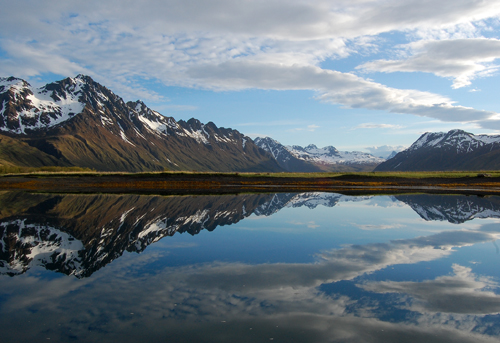
Winter was late to leave Prince William Sound as we headed out of Cordova on May 19th. Thompson Pass above Valdez had just gotten several feet of new snow, and snow was still blanketed the shorelines above the tide line. With each day the snow was slowly retreating, and the melt water was gushing out of streams and the numerous waterfalls that cascade over the mountain ledges.
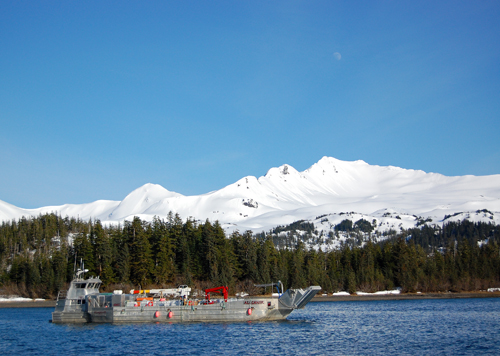
Mountain goats had eluded us in the past, but this season we were lucky to actually get a glimpse of goats as they literally graze on shear cliffs in Sheep Bay (no they’re goats!) , our first anchorage . We saw goats again as we transited MacArthur Pass along the Kenai Peninsula. One reason the goats are so hard to see is that they appear as tiny white dots from a mile away. Only with a good pair of binoculars do they emerge as mountain goats, though they still seem small.
Our cruising plan was to move quickly to the Alaska Peninsula so as to be able to spend as much time out west as possible. Nancy would be leaving Cordova the last week of August for Seattle and onto Oregon to complete another section of the Pacific Crest Trail. She is hoping that the many hours on the boat and some physical therapy would be the downtime needed for her knees to recover from the last hike.
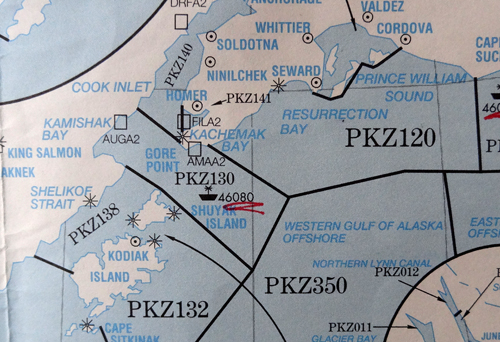
The first obstacle in getting to the Peninsula is crossing the Gulf of Alaska. There are three weather zones that need to be crossed and as we listened to the weather forecast, two areas would be good for crossing but one not good. One way to lessen our exposure time is to continue along the Kenai Peninsula after Prince William Sound, making the crossing time 18 hours instead of 32 hours.
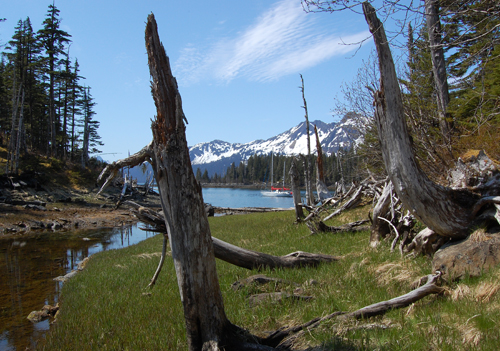
In the waiting there are always pleasant surprises. We had actually left Nuka Bay to cross the Gulf but 20 miles out we had strong head winds and the seas were choppy with waves coming over the bow. The winds were not behaving according to the forecast and we had a hundred miles to go before we could seek shelter. So we turned around and went back to our last anchorage. The result was 2 days waiting in a lovely anchorage where Nancy could try out her inflatable kayak, bought used from a friend in Cordova. When the next favorable forecast came we had an easy crossing all the way to Kodiak.
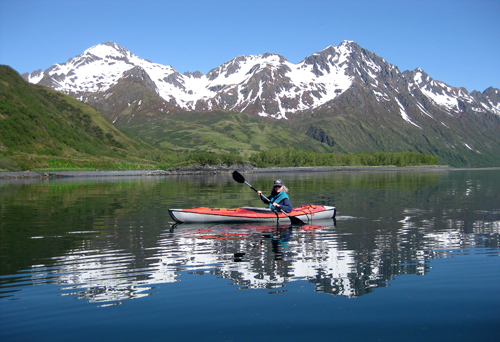
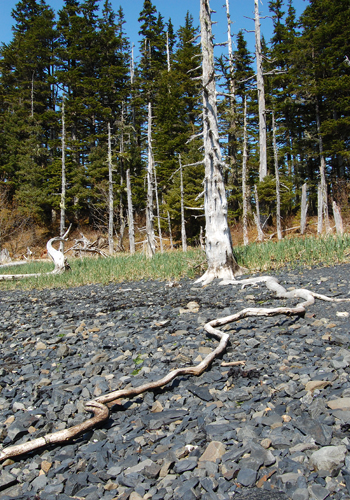
Kodiak City is a good place to re-supply on fresh produce and wine, though visits are kept as short as possible to minimize the coast of harbor fees. Our first day we met Laura and Tom, residents who have a nice motor-sailor, perfect for cruising the Kodiak Islands and Alaskan waters. They offered us the use of a vehicle so we could do shopping the next day, the better stores being a few miles from the harbor. It was especially handy since it rained all the next day and walking, carrying heavy bags would not have been fun. And we had a pleasant dinner at their house afterwards. Thank you Laura and Tom for your generosity!
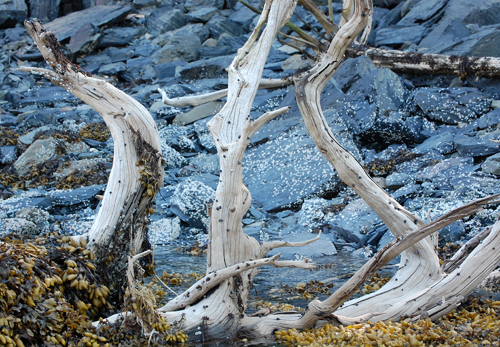
Normally we would head north west through Whale Pass for Shelikoff Straits and continue southeast along the Peninsula. This season we’d proceed along the Pacific side of Kodiak Island, through Sitkalidak Passage, explore the bays west of Old Harbor, continue through Geese Channel past the Trinity Islands and cross over to the Peninsula side.
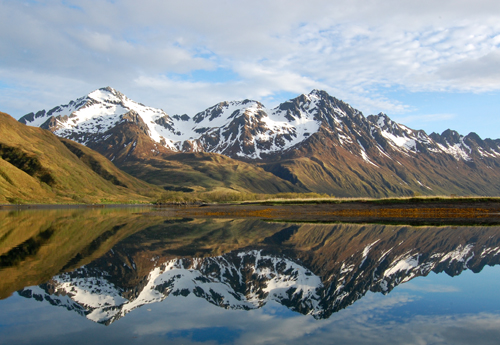
It was decided to wait out the strong westerlies behind a spit in the entrance to Three Saints Bay. We had already waited out a gale in Shearwater Bay, an anchorage we had used in July 2011 (see blog entry July 18, 2010) and were hoping to find an anchorage calm enough to play around on shore. As it turned out, the weather was sunny and clear and the anchorage well protected from the wind, allowing great beachcombing.


Everyday, on the radio weather forecast, it was announced that Pavlof Volcano was active. After leaving Sandpoint we planed on anchoring on the north shore of Dolgoi Island at Bluff Point right under Pavlof, in hopes of seeing the volcano. It had been cloudy and rainy when we anchored and into the next day. But on the second day, as the evening progressed, there were period of clearing on the mountains. First just the ash dusted slopes were visible, but eventually the peaks of Pavlof and Pavlof’s Sister Volcanoes poked through the clouds and the continual belching of smoke from Pavloff was clearly visible.
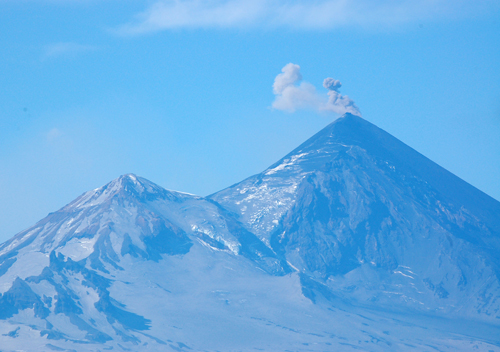
We were headed for Dora Harbor on the south coast of Unimak Island with a forecast for a SE gale, but decided as we approached False Pass to instead to proceed thru False Pass and anchored in an embayment that we knew to be well sheltered. Each new forecast increased the winds until we had continuous 30-40 knot winds in the anchorage itself, with gusts at 40+ k. It’s at these times when our 88 pound Delta anchor and all chain rode is well worth every bit of the weight. After two nights sailing on the anchor, our nerves frayed, we headed into the new small boat harbor at False Pass to sit out the strong NW winds forecast for the next day, as there is no other anchorage to provide shelter from strong north westerlies. But we always enjoy our time spent in the small fishing villages of Alaska, and it would give us opportunity to visit the community and buy a few fresh items from the small, but surprisingly well stocked village store.


Nancy was determined to go to Dora Harbor , but with a forecast for 20-25 k NW winds Mark was not convinced it would be a good anchorage. And he was right!, of course. The first obstacle was trying to avoid the gillnet boats fishing off Cape Pankof The forecast wind was 20+ knots out of the NW, but the effects of the mountainous terrain accelerated and amplified the wind, working up rough seas that made finding the ends of the nets very difficult. Then the forecast was upped to 25-30 k NW winds with gust 35+, again amplified and focused by the imposing mountains, and the two nights in Dora were spent once again hanging by our toenails, unable to get ashore, as it was far too windy to safely launch and use the dinghy. To add to the stress, gillnet boats came in each night to anchor, and always seemed to want to anchor as close as possible to Tamara.
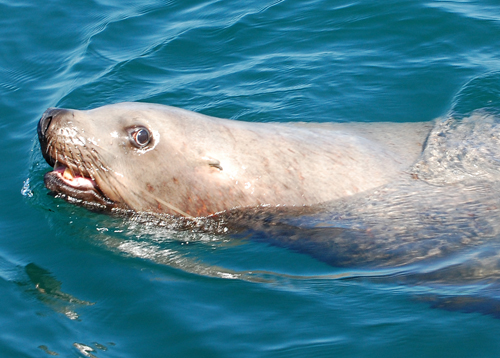
We left Cordova hoping to make some progress out the Aleutian Chain, but the weather to that point hadn’t been cooperating. Technically we were in the Aleutians, just barely. But one has to keep reminding oneself that it’s not the destination but the journey. In another week it would be time to start the trip back to Prince William Sound and the forecast east of Dutch Harbor was for another gale. So we reluctantly decided that Dora Harbor would be as far west as we’d proceed. With the next favorable forecast we began the voyage back to the east. We intend to spend some time exploring little used harbors in the outer islands of the Shumagin group. To that end we’ve been gathering whatever “local knowledge” available, as this region is still poorly charted and seldom visited.
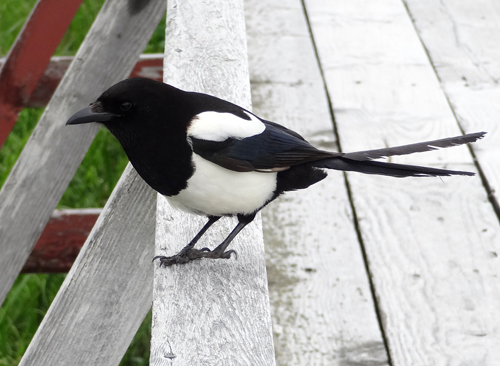
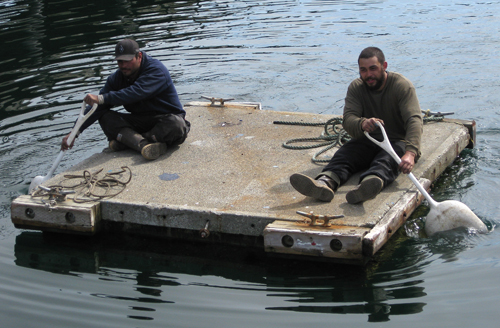
Labels: Alaskan Peninsula, Dora Harbor, False Pass, Kodiak, Three Saints Bay



1 Comments:
Great photography once again. Thank you for sharing your adventure with all of us.
Post a Comment
<< Home